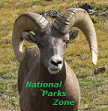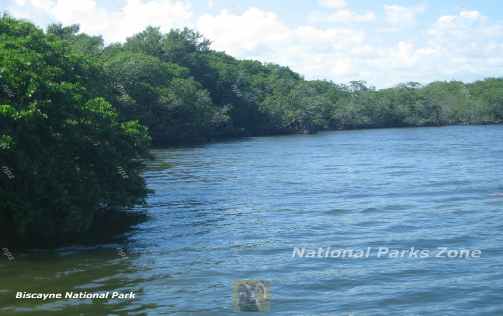Copyright © 2014-
All Rights Reserved

Updated 02/11/23 7:04 PM
Other Resources
Biscayne National Park on the National Parks Service website -
Biscayne National Park -
Biscayne National Park-
Biscayne National Park -
Florida Keys
Biscayne National Park
Situated on a coral reef in Florida’s beautiful Biscayne Bay you can see exotic sea life through glass-
Florida
2010
About The Park
Biscayne National Park is quite different from any other national park. Ninety-
The rest of the park’s land area consists of narrow stretches of mangrove swamp along the mainland Florida coast. It stretches for about 20 miles and is rarely more than a quarter of a mile wide throughout most of its length.
It really doesn’t matter very much how wide it is. You can’t walk on it because it’s a mangrove swamp. The mangrove trees with their multiple roots protruding out from the water make for a nearly impassable barrier to all but aquatic life. These trees were once considered worthless and a wasteland but we now know they are essential to the ecology of the bay, the cleanliness of the waters and they protect the coast line behind it from being washed away by Florida’s frequent tropical storms and hurricanes. They are essentially a barrier and they filter the water.
The only part of the park that’s reachable from the land is the entrance road leading to the Dante Fascell Visitor Center at Convoy Point. It is located a few miles west of the city of Homestead, Florida (which lies south of Miami, Florida) and sits right on the edge of Biscayne Bay. It is situated on a point that looks out at the bay and islands (‘keys’) that make up the national park.
The park’s waters contain many shipwrecks, some of which date to the 17th century when the Spaniards owned Florida. Over the centuries many a vessel met its end up against the reefs surrounding the keys. Sometimes it was a matter of poor navigation; other times sudden storms or hurricanes drove the boats onto the reefs where they were torn apart by the forces of nature.
There’s a concessionaire in the park that offers glass-
You can also take snorkeling and scuba diving trips to the reefs. The equipment can be rented with or without a tour. They also rent kayaks, canoes and paddleboats. The water temperature is typically around 80° all year round which makes for nice swimming conditions.
If you’re a boater there are places that will rent you boats and I guess they assume that you know what you’re doing out on the water given the shallowness of the bay and the dangers of coral reefs. If you’re hauling a boat there are plenty of places to put it into the water and there’s also a limited number of slips that can be rented. Personal watercraft are not allowed in the park.
This is an easy park to see in one day. Visiting the visitor center and looking at the exhibits followed by a glass-
Wildlife
There are 200 species of fish that make the park their home. The bay has a resident population of bottlenose dolphins. American alligator and the threatened American crocodile, which are common to south Florida, are sometimes seen in the mangrove swamps. Manatees like to swim lazily in the still waters of the bay. Lobsters, stone crabs, blue crabs and shrimp can be seen in the waters on the glass-
Naturally, the coastal mangrove swamp environment is conducive to breeding mosquitoes and in the summer months they can be a problem. If you’re out on the water they are less of a problem.
Lodging
There is no lodging in the park. Camping is allowed on some of the keys in the park but they are only reachable by boat. Lodging can be found in the surrounding communities. Homestead, Florida is close and large enough to have many choices of lodging.
Hiking
There are some hiking trails out on some of the keys which can be reached by boat. The coastal areas are mangrove swamps which are pretty much impassable on foot.
Biscayne National Park Photo Gallery


Other National Parks Within a Days Drive
Everglades National Park Alligators, crocodiles and bald eagles populate Florida’s famous ‘river of grass’ and lies just a few miles south.
Dry Tortugas National Park A 140-
*N*P*Z*
National Parks Zone